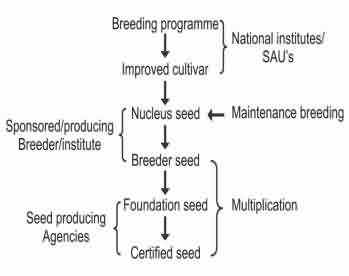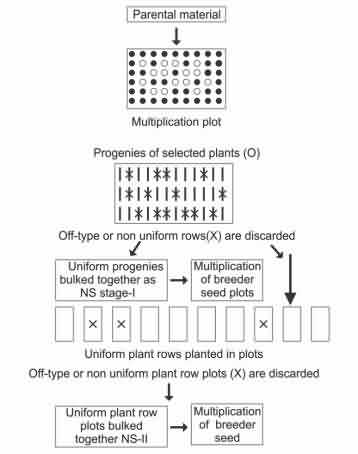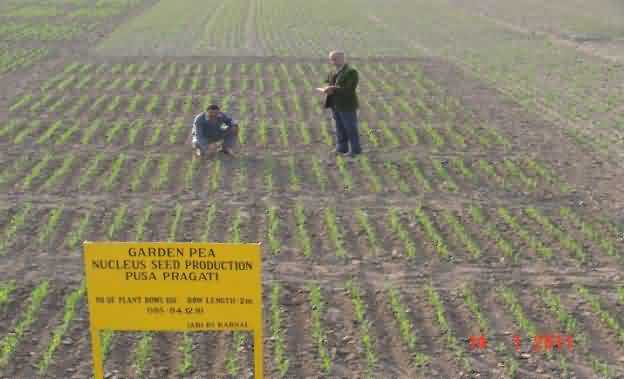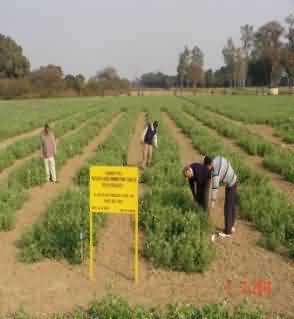स्व-परागण सब्जियों की खेती में प्रजाति संरक्षण और नाभिक बीज का उत्पादन
Vegetable breeding programme results in the production of improved cultivars in vegetable crops. At the time of variety release a small quantity of seed is available with the breeder. The relatively small amount of seed of improved cultivar needs to be multiplied and made available to farmers as quickly as possible.
During seed multiplication, varietal purity and identity needs to be maintained. Each multiplication cycle starts from the ‘breeder seed’. If the breeder seed is not of high purity, the contaminants present get multiplied several times in the succeeding generations of foundation and certified seed production. The presence of contaminants may even lead to complete loss of the improved features of the cultivar. Prevention of contamination is at the heart of a successful breeder seed production programme.
At the Indian Agricultural Research Institute, Regional Station, Karnal, a system of cultivar maintenance and seed production has been evolved for the successful production of breeder seed in vegetable crops.
During seed multiplication process, several factors may reduce the genetic purity of seed. The maintenance of genetic purity is largely dependent on the genetic makeup of the cultivar. Based on pollination mechanism, vegetable cultivars can be classified into four categories
- Self pollinating crops with very little out crossing
- Self pollinating crops with substantial amount of out crossing (often cross pollinated crops)
- Typical cross pollinating crops
- The vegetatively reproductive crops
The diversity of morphological types is normally greater in predominantly cross pollinated crops like brassicas, cucurbits, onion etc than self- pollinated crops like garden pea, vegetable cowpea, fenugreek, tomatoes, etc.
Genetic variation may appear within a seed stock for a number of reasons including mechanical contamination, hybrids resulting from undesirable pollination, recombination, residual segregation, and mutation. These factors ensure that no cultivar is likely to retain the precise frequencies established by the breeder without continuous intervention through maintenance breeding techniques.
Maintenance of a cultivar
Once a cultivar is released for cultivation, the breeder usually supplies a small quantity of seed for further multiplication and maintenance. The responsibility of breeder seed production centre is to produce breeder seed and varietal maintenance. In order to release seed of an improved cultivar to farmers, it has to be multiplied. Each multiplication cycle has to start from its basic seed stock, ‘Nucleus Seed’.

Fig.1 Scheme showing cultivar breeding, maintenance and multiplication in India
Our basic objective of cultivar maintenance is to maintain the purity and identity of a cultivar. The maintenance procedures are in fact the extension of the normal breeding process. The difference is that during maintenance breeding, selection process is relatively mild and our aim is not improvement but to keep the identity unchanged. Selection should maintain the plant type, its uniformity and freedom from diseases.
The maintenance procedures for self pollinating vegetable crops like garden pea, cowpea, fenugreek, tomato etc with a substantial amount of out-crossing are slightly different from cross-pollinating crops. In cross pollinating crops like cauliflower, cabbage, onion, carrot, etc the important characters are assessed before flowering. The fields where plants and progenies are to be assessed should be uniform. Essentially these should be grown under optimal growing conditions.
Cultivar maintenance in self- pollinating vegetable crops
Plant to row method:
The maintenance procedure starts with a small plot raised from the parental material received from the breeder or uniform seed multiplication field in case of established cultivars. A fair number (300-500) of healthy plants typical of the cultivar are selected and marked for progeny testing (Plate 1). The seeds of the marked true - to - type plants are harvested separately. The seeds of each plant are planted in a 3m long progeny row. These progeny rows are assessed critically several times during the growing season. Progeny rows that deviate in one or other characteristics are discarded and entire plant progeny rows is rejected. The plant progenies that are uniform and true to type are selected and bulked together as nucleus seed stage-I. This nucleus seed is used for planting larger breeder seed plots. If the breeder seed requirement of a particular cultivar is more, then another cycle of nucleus seed production is followed (Fig. 2).

Fig. 2 Maintenance scheme for self- pollinating cultivars.
In this case the true- to- type individual plant progenies are harvested and thrashed separately. Seed of each selected plant- row progeny is now sown in a small plot called plant- row- progeny plot (Plate 2). The second cycle of nucleus seed production provides another opportunity to eliminate any plant row progeny showing segregation or off-type plants. The plots with required uniformity and plant type are bulked together to produce nucleus seed stage-II. The product of this second cycle of progeny testing is sufficient to meet the higher requirements of breeder seed particularly in garden pea, vegetable cowpea, etc.

Plate 1: Nucleus seed production (stage 1) in garden pea cv. Pusa Pragati
Many modifications of this scheme are possible. For example in garden pea, where 150 typical plants are selected from seed multiplication plot. These plants are harvested and threshed separately. Next season 150 progeny- rows are planted and critically examined for cultivar characteristic during the entire growing season. The off-type rows and less promising lines about 20% are discarded. Among the remaining 120 progeny rows, the 30 best progeny rows are selected. Ten best plants showing better production are selected from each of the 30 best plant progeny rows. Out of these 10 plants, five best plants showing higher number of seeds per pod are selected. These 5 X 30 plants are used to produce plant progeny rows next year. The remaining seed of 30 best progeny rows is harvested separately and planted as 30 bulk plots next season.


Plate 2 Plant row progeny plots for nucleus seed production (Stage 2) in garden pea cv. Pusa Pragati
Authors:
V.K.Pandita1 and S.C.Rana2
1 Principal Scientist, 2 Senior Scientist
Indian Agricultural Research Institute, Regional Station, Karnal-132001
Email:
